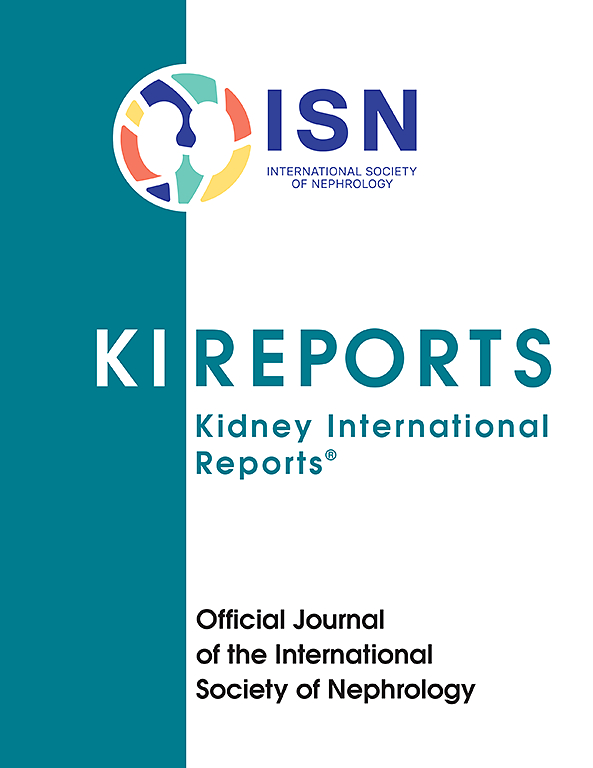用盐计监测血液透析患者钠摄入量
IF 5.7
2区 医学
Q1 UROLOGY & NEPHROLOGY
引用次数: 0
摘要
随着肾功能的下降,血液透析患者逐渐无法调节钠和水的平衡。本研究探讨了血液透析患者使用盐计和强化饮食教育自我监测钠摄入量的可能性。方法采用可行性准实验研究方法,从2个血液透析单位招募血液透析患者;干预组(干预组)和对照组(对照组)分别接受为期8周的强化饮食教育,并结合饮食日记和盐计。在基线、8周和16周时测量血压(BP)和钠相关结果。结果干预组21例,对照组25例。干预组的平均透析间期体重增加(IDWG)保持稳定,但对照组较基线增加了0.9和1.2 kg(分别在第8周和第16周)。干预组患者的平均收缩压较基线下降9.7 mm Hg,对照组患者的平均收缩压分别在第8周和第16周升高10.7和13.7 mm Hg (P < 0.05)。干预组血清钠水平在8周时较基线显著下降1.8 mmol/l (P < 0.05)。结论强化饮食教育结合以盐计为基础的自我监测钠摄入量比单纯标准教育更能有效控制血清钠和血压,提高低盐饮食的依从性。盐计可能有助于支持血液透析患者的钠限制。本文章由计算机程序翻译,如有差异,请以英文原文为准。
Monitoring Sodium Intake With a Salt Meter in Hemodialysis Patients
Introduction
Patients on hemodialysis experience a progressive inability to regulate sodium and water balance as kidney function declines. This study investigated the potential of self-monitoring of sodium intake using a salt meter and intensive dietary education in patients on hemodialysis.
Methods
This feasibility, quasi-experimental study recruited patients on hemodialysis from 2 hemodialysis units; the units as a whole were assigned to receive intensive dietary education in combination with a dietary diary and salt meter for 8 weeks (intervention group) or standard dietary education alone (control group). Blood pressure (BP) and sodium-related outcomes were measured at baseline, and at 8 and 16 weeks.
Results
We analyzed 21 patients in the intervention group and 25 in the control group. Mean interdialytic weight gain (IDWG) remained stable in the intervention group but increased in the control group from baseline by 0.9 and 1.2 kg (at week 8 and 16, respectively). The mean systolic BP decreased by 9.7 mm Hg from baseline to week 16 in the intervention group and increased by 10.7 and 13.7 mm Hg (at week 8 and 16, respectively) in the control group (P < 0.05). Serum sodium levels in the intervention group decreased significantly from baseline by 1.8 mmol/l at 8 weeks (P < 0.05).
Conclusion
Intensive dietary education combined with salt meter–based self-monitoring of sodium intake was more effective than standard education alone in controlling serum sodium and BP with improved adherence to the low-salt diet. Salt meters may be useful to support sodium restriction in patients on hemodialysis.
求助全文
通过发布文献求助,成功后即可免费获取论文全文。
去求助
来源期刊

Kidney International Reports
Medicine-Nephrology
CiteScore
7.70
自引率
3.30%
发文量
1578
审稿时长
8 weeks
期刊介绍:
Kidney International Reports, an official journal of the International Society of Nephrology, is a peer-reviewed, open access journal devoted to the publication of leading research and developments related to kidney disease. With the primary aim of contributing to improved care of patients with kidney disease, the journal will publish original clinical and select translational articles and educational content related to the pathogenesis, evaluation and management of acute and chronic kidney disease, end stage renal disease (including transplantation), acid-base, fluid and electrolyte disturbances and hypertension. Of particular interest are submissions related to clinical trials, epidemiology, systematic reviews (including meta-analyses) and outcomes research. The journal will also provide a platform for wider dissemination of national and regional guidelines as well as consensus meeting reports.
 求助内容:
求助内容: 应助结果提醒方式:
应助结果提醒方式:


